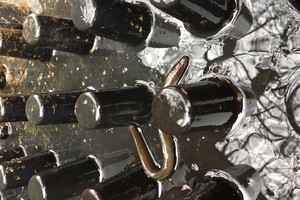Improving fish and eel passage on the Bristol Frome
The Environment Agency has begun work to make it easier for fish and eels to swim up and down the River Frome in Yate, north Bristol.

Eels will use the gaps between the cones on the eel tiles to wriggle through and help them climb
Four weirs on the stretch of river running through Yate are being modified.
A small notch is being cut into 3 of the weirs, and eel tiles and baffles are being fixed to the fourth weir, making it easier for fish and eels to swim upstream and reach important spawning ground.
By improving the weirs, it is hoped this will help increase the number and variety of fish found locally. The work is a key part of fish passage in the catchment as it will allow easier access to 8.6 kilometres of upstream river.
The work on the weirs began last week and is due to be completed mid-May.
The 4 weirs are part of a flood defence scheme built in the 1960s. The scheme funnels high flows of water past Yate to reduce the risk of flooding. The river was significantly shortened and straightened when the flood scheme was built, and the weirs help prevent erosion of the riverbed.
The Frome is home to brown trout, stone loach, minnow, stickleback, and bullhead – and the endangered European eel.
European eels spawn in the Sargasso Sea in the North Atlantic Ocean, before floating in their larval form on ocean currents towards Europe. Once they reach the freshwater estuaries around the coast, like the Bristol Channel, they turn into elvers and swim up into rivers, including the Frome, where they spend up to 20 years living and feeding. Once they have grown and matured, they swim all the way back to the Sargasso Sea (nearly 5,000 kilometres) where they lay their eggs.
To help eels travel upstream eel tiles are being attached to the wall at the side of one of the weirs. The eel tile is a blank board on one side, but on the other side of the board facing the wall, are lots of little cones.
Because eels are long and thin, they are not very good swimmers, but they are very good at wriggling and crawling. Eels can use the gaps between the cones to wriggle through and this will help them to climb over the weir.
Baffles - long strips of recycled plastic attached to the front of the weir - help to concentrate flows of water by channelling the water through notches cut into the plastic. This increases the depth of water and reduces the speed so that fish can swim through the notches and over the weir.
Heather Barker, Bristol Frome project manager at the Environment Agency, said:
This work should see an increase in the number and variety of fish we find in the Frome, and generally make this a better place for people and wildlife.
The work is part of a wider programme of projects through the Frome Reconnected Partnership to improve the River Frome. The weirs along this stretch of river are surrounded by public open space and alongside the Frome Valley Walkway. We hope the local community will appreciate the work we are doing to improve the local environment and value the river and its habitats.